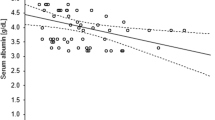Abstract
To evaluate the usefulness of monitoring the pharmacokinetic of mycophenolic acid (MPA) in lupus nephritis (LN), in order to optimize the mycophenolate mofetil (MMF) dose in the single patient. Five consecutive patients with active LN were studied. After standard induction therapy with MMF, MMF was titrated to achieve a stable target of MPA-AUC0-12h of 45–60 mg.h/l during the maintenance treatment. For MPA assays, blood samples were collected at 0, ½, 1 ¼, 2, 4, 6, 8 and 12 h after the morning dose. Plasma MPA concentration was measured using a validated high-performance liquid chromatography. Treatment response was evaluated at baseline, i.e. at the end of the induction therapy and during maintenance therapy with MMF. The average whole follow-up was 21.4 months. At the last visit, a complete renal response was registered in all the five patients. No renal flares were observed. Glucocorticoids were suspended in all. The mean MPA-AUC0-12h of MMF at the last visit [56.74 (±2.9) mg.h/l] was significantly lower than MPA-AUC0-12h at baseline [98.7 (±24.6) mg.h/l] (p = 0.009), since the dose of MMF was significantly reduced in all the patients [from 2.8 g/day (±0.4) to 1.9 g/day (±0.4) (p = 0.018)] based on the target MPA-AUC. No severe adverse events were observed. Assessment of MPA pharmacokinetics may be useful to optimize the maintenance therapy of lupus nephritis with MMF, possibly improving the efficacy and minimizing the side effects.
Similar content being viewed by others
References
Appel GB, Contreras G, Dooley MA et al (2009) Mycophenolate mofetil or intravenous cyclophosphamide for induction treatment of lupus nephritis. J Am Soc Nephrol 20:1103–1112
Dooley MA, Jayne D, Ginzler EM et al (2011) Mycophenolate versus azathioprine as maintenance therapy for lupus nephritis. N Engl J Med 365(20):1886–189
Houssiau FA, D’Cruz D, Sangles S et al (2010) Azathioprine versus mycophenolate mofetil for long-term immunosuppression in lupus nephritis: results from the MAINTAIN Nephritis Trial. Ann Rheum Dis 69(12):2083–2089
Le Meur Y, Buchler M, Thierry A et al (2007) Individualized mycophenolate mofetil dosing based on drug exposure significantly improves patients outcomes after renal transplantation. Am J Transplant 7:2496–2503
Lertdumrongluk P, Somparn P (2010) Pharmacokinetics of mycophenolic acid in severe lupus nephritis. Kidney Int 78:389–395
Kittanamongkolchai W, Rukrung C (2013) Therapeutic drug monitoring of mycophenolate mofetil for the treatment of severely active lupus nephritis. Lupus 7:727–732
Zahr N, Arnaud L, Marquet P et al (2010) Mycophenolic acid area under the curve correlates with disease activity in lupus patients treated with mycophenolate mofetil. Arthritis Rheum 62:2047–2054
Daleboudt GM, Reinders ME, den Hartigh J et al (2013) Concentration-controlled treatment of lupus nephritis with mycophenolate mofetil. Lupus 22:171–179
Tan EM, Cohen AS, Fries JF et al (1982) The 1982 revised criteria for the classification of systemic lupus erythematosus. Arthritis Rheum 25:1271–1277
Weening JJ, D’agati VD, Schwartz MM et al (2004) The classification of glomerulonephritis in systemic lupus erytematosus. J Am Soc Nephrol 15:241–250
Shaw LM, Korecka M, Van Breeman R (1998) Analysis, pharmacokinetics and therapeutic drug monitoring of mycophenolic acid. Clin Biochem 31:323–328
Baraldo M, Isola M, Feruglio MT et al (2005) Therapeutic mycophenolic acid monitoring by means of limited sampling strategy in orthotopic heart transplantation patients. Transplant Proc 37:2240–2243
Bertsias GK, Tektonidou M, Amoura Z et al (2012) Joint European League Against Rheumatism and European Renal Association-European Dialysis and Transplant Association (EULAR/ERA-EDTA) recomendations for the management of adult and pediatric lupus nephritis. Ann Rheum Dis 71:1771–1782
Van Gelder T, Le Meur Y, Shaw LM (2006) Therapeutic drug monitoring of mycophenolate mofetil in transplantation. Ther Drug Monit 28:145–154
Laskari K, Mavragani CP, Tzioufas AG, Moutsopoulos HM (2010) Mycophenolate mofetil as maintenance therapy for proliferative lupus nephritis: a long-term observational prospective study. Arthritis Res Ther 12:R208
Conflict of interest
None.
Author information
Authors and Affiliations
Corresponding author
Rights and permissions
About this article
Cite this article
Zabotti, A., Baraldo, M., Quartuccio, L. et al. Optimizing the dose of mycophenolate mofetil for the maintenance treatment of lupus nephritis by therapeutic drug monitoring. Clin Rheumatol 34, 171–174 (2015). https://doi.org/10.1007/s10067-014-2786-9
Received:
Accepted:
Published:
Issue Date:
DOI: https://doi.org/10.1007/s10067-014-2786-9




